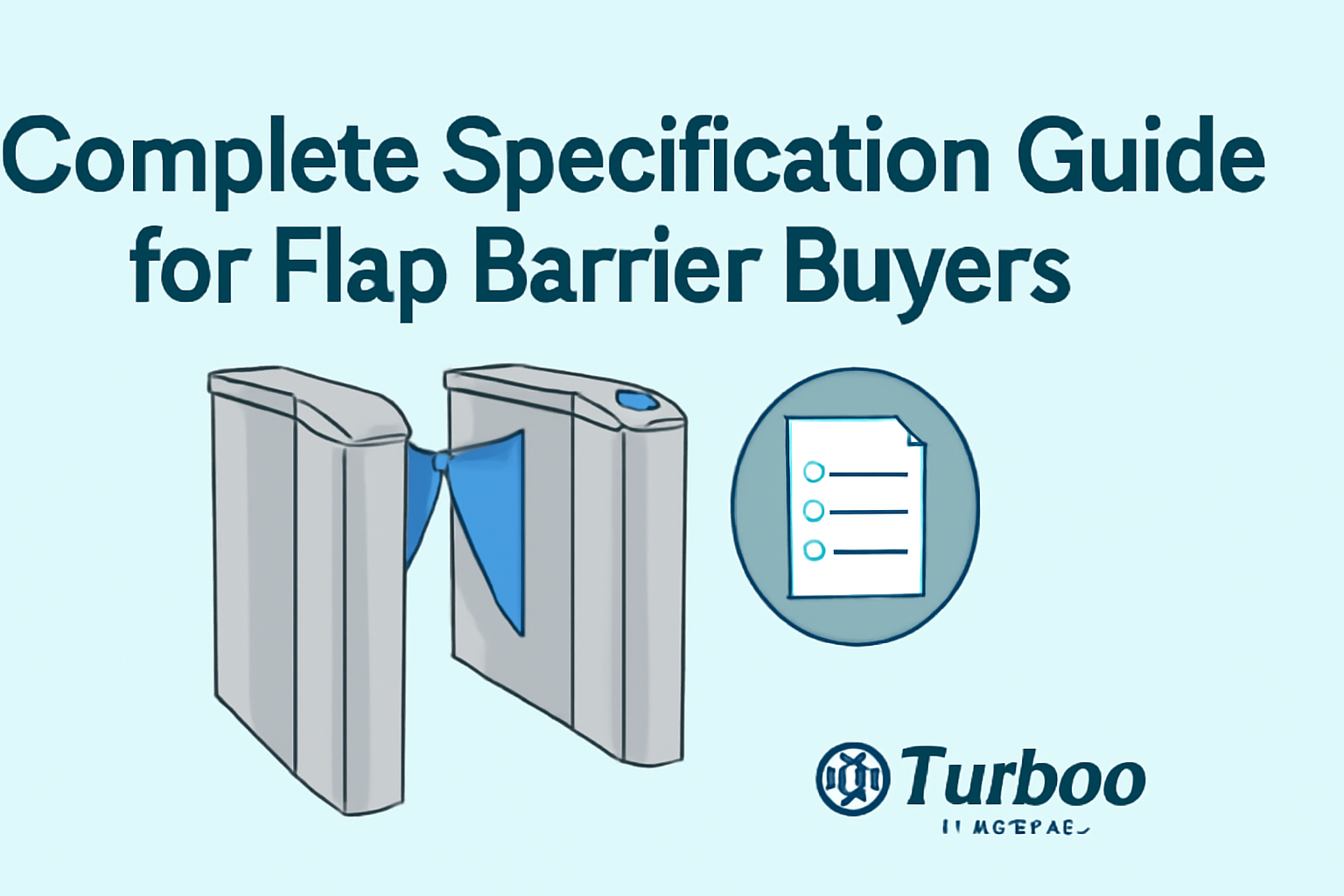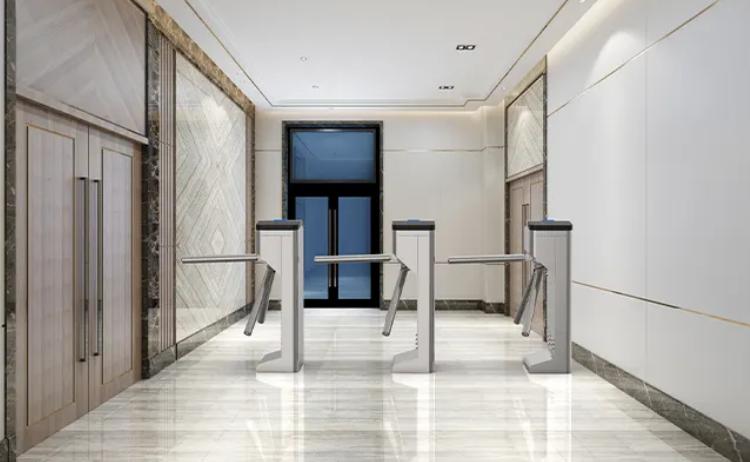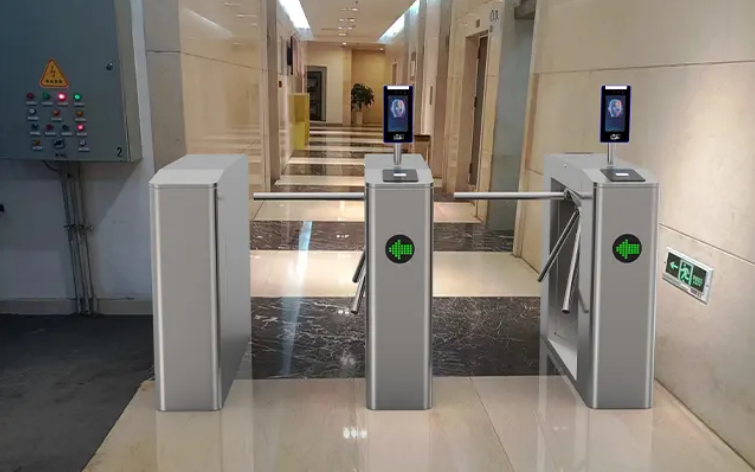Complete Specification Guide for Flap Barrier Buyers


When buying a flap barrier system, many buyers focus on the surface features like design or brand without considering the detailed technical specifications for flap barriers. This oversight can lead to costly mismatches, operational inefficiencies, and performance issues down the line. Understanding the full scope of flap barrier specs is crucial for ensuring that your system is not only suitable for your site but also performs reliably over its lifecycle.
Detailed specifications aren’t just numbers—they dictate how well the barrier will integrate with existing systems, how long it will last, and how efficiently it will operate. With so many choices available, a clear understanding of these specs helps ensure you don’t make a decision that could end up costing more in maintenance, repairs, or even security gaps.
This guide breaks down complex flap barrier specs into clear, actionable information. Whether you’re a facility manager, procurement officer, or security planner, by the end of this guide, you’ll be equipped with a solid understanding to confidently evaluate flap barrier options and make the best choice for your project.
Dimensions and Passage Width
The first technical specification you need to consider is the dimensions of the flap barrier, particularly the passage width. The passage width directly affects how many users can pass through in a given amount of time and determines whether the barrier suits your specific facility needs.
Standard passage sizes typically range from 550mm to 600mm, which works for most typical buildings, such as offices or smaller retail spaces. However, for high-traffic areas like airports or stadiums, a wider passage width (up to 900mm or more) might be required to accommodate large crowds or people with mobility aids.
Choosing the right passage width can also influence user flow. A barrier with a narrower opening will naturally have slower throughput because people have to pass through one by one, which might cause congestion during peak hours. On the other hand, excessively wide gates can be unnecessary in small or medium-sized facilities and can increase costs without providing significant benefits.
Additionally, the barrier dimensions also include the cabinet size, height, and depth. These need to be considered for installation space—is there enough clearance in your chosen area? It’s important to make sure the system fits into the designated area with room for proper installation and maintenance access.
Material Quality and Durability
The materials used to construct the flap barrier system affect its durability, longevity, and maintenance requirements. Quality materials ensure the barrier will stand up to daily use, environmental factors, and occasional accidents.
Common materials for flap barriers include stainless steel, aluminum, and tempered glass. Stainless steel is particularly popular because of its resistance to corrosion, especially in high-traffic or high-humidity areas like airports or train stations. It also has a sleek, modern aesthetic, making it ideal for commercial buildings.
Another key material consideration is the flap wings. These can be made from acrylic, tempered glass, or polycarbonate. Acrylic and polycarbonate are lightweight and impact-resistant, which is important for both safety and longevity. Tempered glass provides a clean look but can be more prone to cracking under stress or impact.
Additionally, consider the finish of the materials. For example, some models offer powder coating or anti-fingerprint finishes to keep the barrier looking pristine even after repeated use. This also impacts the cleaning and maintenance cycle, which should be low-maintenance to avoid frequent repairs and upkeep.
The material choice also plays a role in the barrier’s ability to withstand environmental factors. In harsh climates or locations, make sure the materials chosen have high corrosion resistance and can endure varying temperatures or physical wear and tear.
Speed and Throughput Capacity
Speed and throughput capacity are crucial specs, particularly for facilities that see high foot traffic, such as transportation hubs, shopping centers, and large office buildings. Flap barriers are generally designed to open and close within a time frame of 0.3 to 0.6 seconds, ensuring smooth user flow.
The opening speed affects user experience. If the flap barrier is too slow, it can lead to congestion and frustration. However, speed must be balanced with safety—too rapid a movement can potentially cause injury or disrupt flow. This is why a moderate and controlled flap speed is essential for both efficiency and safety.
Throughput capacity refers to how many people can pass through the barrier in a given period, typically measured in users per minute (UPM). For example, a barrier with a throughput of 25-40 users per minute may be sufficient for a small office building, but a busy transportation hub might require a barrier with a higher throughput of 50-70 users per minute.
Consider the traffic flow during peak and off-peak hours when selecting the speed and throughput specifications. Barrier systems should support peak capacity without unnecessary delays while allowing for smooth transitions in quieter times. This flexibility ensures your system is responsive to both normal and emergency situations.
For additional performance benchmarks and to compare different systems, consult this specifications guide.
Safety Features and Emergency Functions
Safety should never be compromised when it comes to flap barriers. Ensuring the barrier is equipped with proper safety features is crucial for minimizing risks to users.
The primary safety features in flap barriers are anti-pinch protection and obstacle detection. Anti-pinch protection uses sensors to detect if a user’s body or an object is obstructing the flap as it moves. If an obstruction is detected, the system immediately halts the motion and reverses the flaps to prevent injury. This is especially important in environments with high foot traffic or where users may not be paying full attention, such as transit stations.
Obstacle detection ensures the barrier knows when a user has fully cleared the gate. If someone tries to push through or if an object blocks the barrier mid-cycle, the system detects the interference and stops, avoiding accidents or damage.
Another critical safety function is the emergency override. During an emergency (such as a fire or security breach), the barrier should be able to open automatically or be manually overridden to ensure safe and efficient evacuation. This fail-safe capability ensures that barriers do not become obstacles during a critical moment.
Power Requirements and Energy Efficiency
Power consumption is a vital consideration when selecting a flap barrier, especially for facilities where long-term operational costs need to be kept in check. Typically, flap barriers are designed to operate with AC 110–220V power inputs, but it’s essential to verify that the system can handle your facility’s power grid specifications.
Energy efficiency plays a significant role in lowering operating costs. Many modern systems incorporate features like sleep modes or low-power standby functions, which reduce energy consumption when the system is idle. For example, some barriers automatically reduce motor power when not actively in use, allowing them to consume minimal energy while maintaining readiness.
Additionally, battery backup systems are another critical factor, particularly in facilities where consistent operation is essential during power outages. These backup systems allow the flap barrier to maintain operation in the event of a power failure, ensuring continuous access control even during emergencies.
When assessing energy efficiency, also consider the motor type. Brushless DC motors, for instance, are more energy-efficient and have a longer lifespan compared to traditional brushed motors. This can contribute significantly to reducing the total cost of ownership and increasing the overall reliability of the system.
Lastly, assess the power consumption over time. For example, if the barrier operates continuously for several hours a day, check the power draw during peak operation and when in standby mode. This can help you calculate energy costs over the barrier’s lifespan and factor that into your purchasing decision.
Control System Compatibility
Flap barriers often integrate with complex access control systems that include card readers, biometric scanners, and security software. It’s critical to ensure that the flap barrier you choose is compatible with your existing systems. Control system compatibility plays a significant role in ease of installation and operation.
Most flap barriers are compatible with RFID card readers, QR code scanners, and biometric access systems (fingerprint, facial recognition, etc.). However, you need to verify that the barrier can communicate seamlessly with these systems. Check for support of common access protocols such as Wiegand, RS-485, or TCP/IP for network-based systems.
Additionally, evaluate integration with central security software. Does the barrier system connect to your building’s security platform? Can it share event logs, user data, or status updates? A well-integrated system provides real-time monitoring and ensures smooth operation, where the barrier can be controlled or configured remotely.
Another essential factor is the user management capabilities. Ensure that the barrier can handle the volume of users and can be configured to work with your current or future user databases.
Lastly, verify whether the flap barrier system allows for software updates to keep pace with evolving technology. Barriers that support over-the-air updates or provide easy firmware upgrades will allow you to future-proof your system and stay ahead of evolving security needs.
For more insights on system compatibility, refer to the functions guide, which can provide further details on how specifications link to barrier capabilities.
Environmental and Protection Ratings
Flap barriers are often deployed in diverse environments, ranging from office buildings and retail spaces to outdoor terminals or factory floors. The environmental rating of a flap barrier determines how well it can withstand various weather conditions, environmental factors, and physical wear.
Look for IP ratings when evaluating a flap barrier’s environmental suitability. IP54 is a common rating for indoor use, ensuring protection against dust and light water splashes. For outdoor applications, look for higher ratings, such as IP65 or higher, to ensure the barrier is fully dustproof and can withstand heavy rain or extreme conditions. These ratings are essential to ensure that the barrier will not degrade prematurely due to exposure to harsh environmental conditions.
If the barrier will be used in areas subject to high or low temperatures, make sure the system is rated to perform reliably within your location’s temperature range. Flap barriers that can operate in a wide temperature range (e.g., -20°C to 70°C) are essential for areas with extreme climates or outdoor applications.
Also, pay attention to the barrier’s corrosion resistance. If you plan to install the barrier in a coastal or industrial environment, select one that is built with corrosion-resistant materials, such as stainless steel, or with special coatings that protect against saltwater or chemicals.
By ensuring your flap barrier has the appropriate environmental protections, you can avoid early degradation, avoid unnecessary repairs, and extend the lifespan of the system.
Installation Considerations
Flap barriers are not plug-and-play systems; their installation requires careful consideration of the space and technical requirements at the deployment site. Proper installation ensures that the system functions smoothly and minimizes the need for future adjustments or maintenance.
First, evaluate the installation footprint. You must ensure there is enough space for the barrier, including the cabinet and the swing path of the flaps. If you’re retrofitting an existing space, measure the available area and check that the barrier dimensions will fit within it without restricting other operations.
Also, consider alignment. The barrier must be level and aligned for proper movement of the flaps. Misalignment can cause jamming or improper operation, leading to more frequent maintenance issues. Proper foundation preparation is key, especially if the barrier will be installed on uneven or soft ground.
For wiring and power requirements, check the cabling needs. Ensure that you can connect the barrier to your facility’s electrical system without excessive modification. Look for models that allow for easy cable management, and be sure to verify the power input requirements.
Don’t forget about grounding. Proper grounding ensures the safety and reliability of the system. It helps prevent electrical shocks, especially when the barrier is exposed to moisture or high traffic.
For more detailed installation requirements, it’s always best to consult the vendor’s installation manual or reach out to the supplier for specific recommendations. This will help avoid installation delays and ensure the system is set up correctly the first time.
Compliance with Industry Standards
Flap barriers should comply with various industry standards and regulations that ensure their safety, functionality, and compatibility with other security systems. Compliance ensures that your installation is both secure and meets all required legal and operational guidelines.
Key standards to look for when reviewing flap barrier specifications include ISO standards, ANSI norms, and SIA (Security Industry Association) certifications. Compliance with these standards ensures that the barrier meets minimum safety and performance expectations and helps avoid legal or operational issues.
For example, barriers in high-security areas like government buildings or data centers must meet higher access control standards, often aligned with certifications such as FIPS 201 for federal access control systems.
Review the certification details provided by the manufacturer. Check for compliance with relevant local or regional regulations regarding fire safety, emergency egress, and accessibility (e.g., compliance with ADA for accessibility in public spaces). These certifications can help guide your purchase decision and ensure that your barrier installation adheres to legal requirements.
By ensuring your barrier meets the appropriate standards, you can also rest assured that the system will be safe, reliable, and compliant throughout its lifecycle.
Understanding Barrier Functions
Each flap barrier system has a set of specific functions designed to enhance its performance and adaptability to different environments. Understanding how flap barrier specs relate to these functions is critical when making a purchasing decision.
For example, consider the barrier’s entry modes. Some barriers are designed to allow one-way or two-way access, while others can operate in free passage or restricted access modes. These functionalities depend on the control system and how well the system can integrate with your facility’s access management software.
Another important function is tailgating prevention. Some systems use infrared sensors to detect unauthorized attempts to follow behind an authorized user. This is particularly important in high-security environments, such as data centers or restricted areas. The sensor setup in the barrier’s specs determines how accurately it can prevent tailgating, so it’s crucial to verify that this feature meets your security needs.
Additionally, check for security alarm integration. Some flap barriers come with built-in alarm features that activate when unauthorized access is detected or when a barrier is tampered with. These alarms can be integrated into a broader security system to provide real-time alerts for security teams.
Review the control board features, as these define the extent of customizable functions the barrier can support. Control boards manage everything from motor speed to access permission settings. Ensuring the system is flexible enough to adapt to your changing needs can future-proof your purchase.
For a comprehensive understanding of how specs connect with functions, take a look at this detailed functions guide.
Common Misunderstandings in Flap Barrier Specs
When evaluating flap barriers, there are several common misunderstandings buyers encounter. These misconceptions can lead to choosing the wrong system, which results in poor performance and wasted investment.
A common mistake is overestimating throughput capacity. While some suppliers tout high user throughput rates, the actual performance may not match these claims in real-world scenarios. Testing the barrier under actual site conditions or consulting with other users in similar environments can give you a more accurate sense of its throughput capabilities.
Another issue is underestimating integration needs. Buyers may assume that the flap barrier will seamlessly integrate with their existing access control systems. However, compatibility issues can arise if the software or hardware isn’t fully aligned. Always verify that the barrier works with your current or future infrastructure, particularly for biometric systems or mobile access solutions.
Some buyers also misinterpret safety feature specifications. A barrier might claim to have anti-pinch sensors, but these may only be effective when the user is positioned directly in the flap’s path. Consider evaluating how these sensors perform under varying conditions to ensure they offer adequate protection.
Finally, focusing only on upfront cost can be a critical mistake. While price is an important factor, it should not be the deciding one. Long-term costs, including maintenance, energy use, and potential repairs, should factor heavily into the decision-making process. A higher initial investment in quality materials and advanced features often leads to reduced maintenance costs and a longer operational life.
Matching Specs to Site Needs
Understanding the specific needs of your site is essential when evaluating flap barriers. The technical specifications should align with the demands of your facility, such as traffic volume, security requirements, and environmental conditions.
For high-traffic environments, focus on barriers with higher throughput capacity and speed settings. These systems need to accommodate large numbers of people efficiently while maintaining security. Conversely, if your site has lower traffic, you might opt for a system with more basic specifications to reduce upfront costs without sacrificing performance.
If your facility is in a harsh environment (e.g., an outdoor location or a building exposed to extreme temperatures), consider the material durability and protection ratings of the barrier. For instance, an IP65-rated system is better suited for outdoor installations than one rated only for indoor use.
Security priorities also affect spec choices. In facilities with sensitive data or high-value assets, prioritize tailgating prevention and integrated alarms. If you have a public or semi-public space, accessibility features like ADA compliance may become more important.
It’s also essential to consider long-term scalability. Choose barriers with specifications that can grow with your facility’s future needs, whether through modular upgrades, added software support, or system expansions.
Using the buying guide will help you match these specs to your site’s unique requirements, ensuring that your investment will support your operations for years to come.
Conclusion
Selecting the right flap barrier is a vital decision that impacts both security and user experience. Understanding flap barrier specs ensures that your system is well-suited to your specific operational needs, whether it’s handling high foot traffic, securing a sensitive area, or enduring harsh environmental conditions.
By following the guidelines in this specification guide, you’ll be able to make informed choices that prevent performance issues and costly mismatches. Whether you’re focused on speed, material quality, energy efficiency, or safety, understanding how each specification impacts your barrier’s performance will help you choose a system that delivers long-term value.
Equip yourself with the knowledge to confidently evaluate options and choose the flap barrier that best fits your needs, ensuring secure and smooth access control.
FAQs
Q1: What is the best passage width for high-traffic areas?
For high-traffic locations like airports or stadiums, consider barriers with a passage width of 900mm or more to allow smoother movement.
Q2: Can flap barriers operate in freezing temperatures?
Yes, but ensure that the system is rated for low-temperature environments. Look for barriers with temperature ranges that extend to -20°C or lower for outdoor installations.
Q3: What is the average lifespan of a flap barrier system?
A well-maintained flap barrier system typically lasts 7–10 years, depending on usage, environment, and material quality.
Q4: Can flap barriers integrate with mobile access systems?
Yes, many modern systems support integration with mobile access using NFC or Bluetooth, provided they are compatible with your existing software.
Q5: Are all flap barriers compliant with safety standards?
Most flap barriers adhere to basic safety standards, but always verify ISO or SIA certifications to ensure they meet the highest industry benchmarks.












